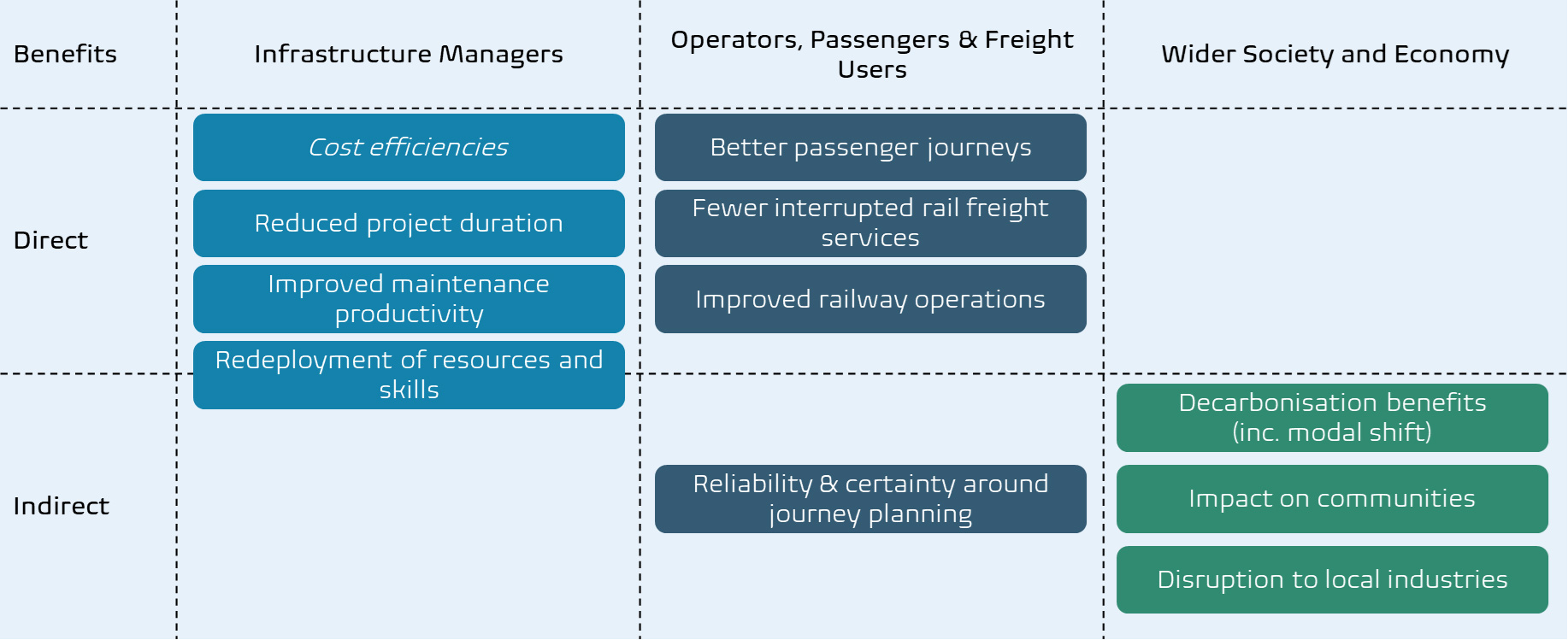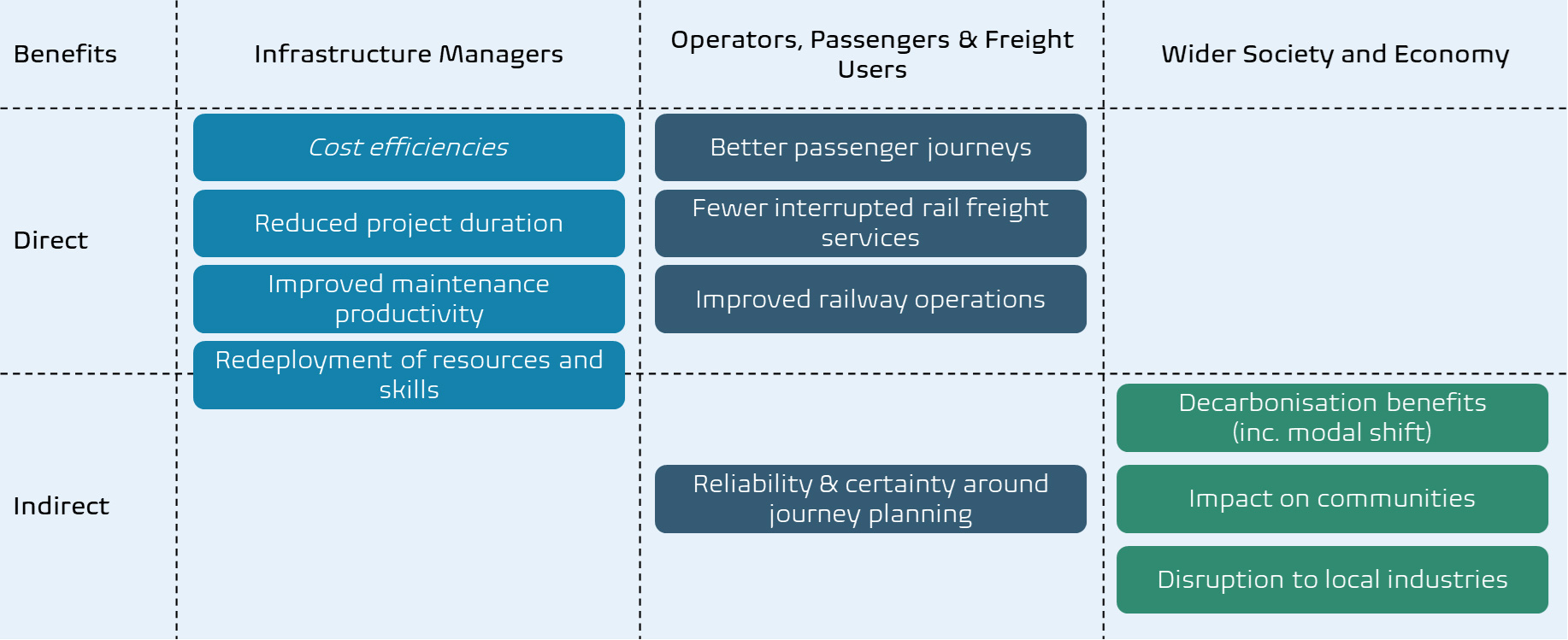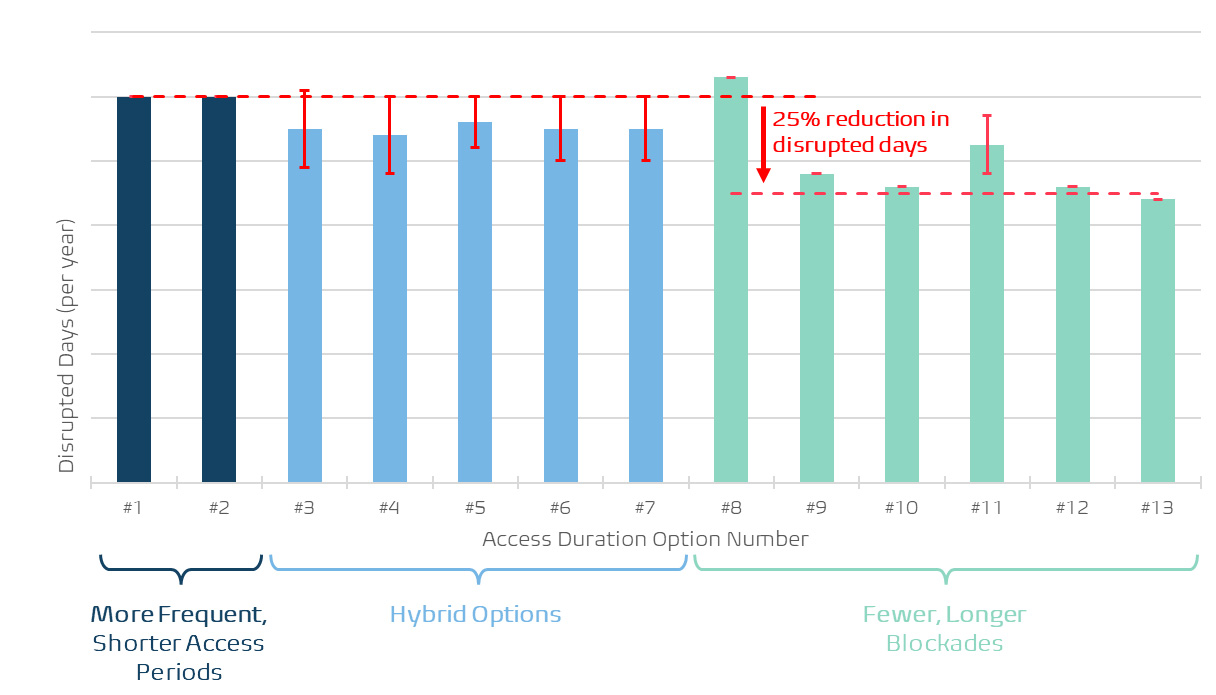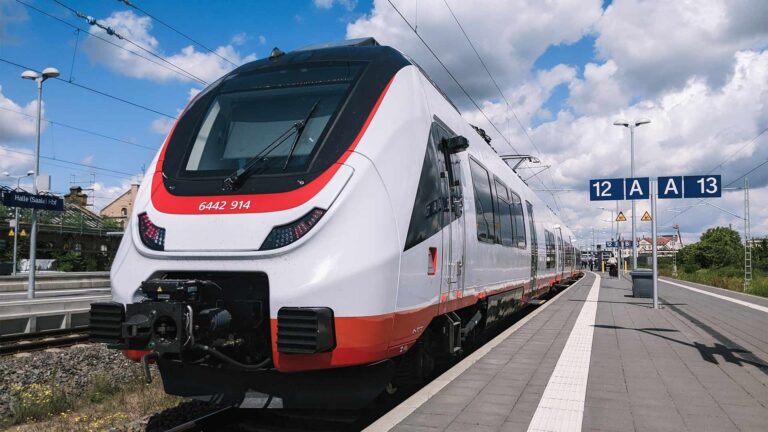Enhancing Rail Engineering Access From Disruption to Efficiency
Executive summary
Most assets need a downtime period for maintenance, from software updates for IT equipment to shop closures for renovations. For rail infrastructure, maintenance often requires stopping all regular services operating on the infrastructure network. Such downtime periods in the rail industry are referred to as “engineering access” and come in several forms, including regular overnight periods to longer, disruptive line closures (known as “blockades”).
Social costs and benefits of engineering access for infrastructure maintenance are not well understood. This is despite benefits for new railway infrastructure are very well documented. It is critical to understand the costs and benefits better as rail infrastructure is an ageing asset with an increased need for maintenance. A better understanding of the social benefits of engineering access would lead to better benefit-cost ratios, better decision-making and less disruption as a result.
The challenges of improving maintenance and engineering access are complicated by the structure of the railway system. Since the EU’s 4th Railway Package was introduced in 2016 rail systems have been moving away from vertical integration, separating the operation of track from train. Even though the 4th package is very successful overall, the increased separation between track and train has made planning engineering access more difficult and less holistic. In the UK – frontrunner in less vertically integrated railway systems – this problem is experienced. In the UK, improving engineering access would yield £365m in benefits, annually.
To further the understanding of social benefits of maintenance within the sector, we have developed an Engineering Access Benefits Framework (Figure 1) which highlights the key direct and indirect benefits of improved engineering access. Each benefit has been described in detail in this document.

Figure 1 – Engineering Access Benefits Framework
We have recently worked with Network Rail to improve access planning and lessons can be learnt to be applied to other projects and in similar systems, globally. Through optimised planning and closer integration with industry partners, customer benefits can be unlocked. This includes driving improvements in maintenance productivity and reducing overall disruption through longer, but less frequent, periods of access.
To achieve this optimisation, we have established there is need for a collaborative (market-focused) approach, improved capacity studies, and improved timetabling data and architecture. Specifically, the following improvements should be implemented:
- Improved coordination between infrastructure managers and operators, to achieve a more holistic planning approach.
- Focus on operational (access) requirements alongside engineering requirements when planning projects.
- Better governance leading to more integrated planning, a more strategic approach looking at nationwide impacts and better leadership focus.
- Putting freight on an equal footing to passenger services to ensure its specific requirements are better reflected.
- Investing in the improvement of diversionary routes – such as line speed improvements, increased capacity during disruption, electrification or increased gauge clearance for freight trains.
Further work is required to apply and test the Engineering Access Benefits Framework in other projects and to understand how bespoke, holistic access decisions can be made for individual maintenance requirements. In addition, many of the benefits identified need to be researched further and quantified so they can be included in benefit cost ratios, used as clear evidence in access strategies and improve the insight offered to decision-makers. The rail industry needs to consider how it delivers engineering access so that overall duration is reduced, the outputs and efficiencies are maximised and the disruption to users minimised, following better access strategies.
Introduction – maintenance of the railway causes costly disruption
Most assets need a downtime period for maintenance, from software updates for IT equipment to shop closures for renovations. For rail infrastructure, maintenance often requires stopping all regular services operating on the infrastructure network. Such downtime periods in the rail industry are referred to as “engineering access” and come in several forms, including regular overnight periods to longer, disruptive line closures (known as “blockades”).
These access periods allow infrastructure managers (such as Network Rail in the UK, DB Netze in Germany or SNCF Reseau in France) the time to safely maintain, renew and overhaul the infrastructure to preserve functionality and ensure safety and regulatory compliance. Access periods are planned in advance (and consequently are sometimes referred to as “planned disruption”) to give train operators, passengers, freight users and the wider industry sufficient time to arrange revised timetables, diversionary rail routes and alternative transport (such as replacement buses for passengers or trucks for freight). Even in the case of planned disruption, this reduces current and future demand, has the potential for long-term reputational damage to rail as a transport mode, and may impact the wider (local, regional or national) economy.
Disruption caused by engineering access bears significant social costs. Reducing the amount of access required while still meeting engineering requirements should yield significant benefits by reducing the social cost impact. Such an approach would require planning across the network to ensure each access period is maximised and making trade-offs to balance – and minimise overall – the impact for passengers and freight users.
For completely new infrastructure, the social costs and benefits are well understood and considered. The value of investing in maintenance is also well documented and the efficiencies and cost savings it can deliver. However, upon review, there is not conclusive, detailed or quantified research into the social benefits of maintenance planning (including engineering access). Because of this, the case for optimising maintenance planning and engineering access is often only based on cost factors, ignoring further benefits such optimisation may yield.
Looking only at cost (ignoring any further social value), in the UK alone, Network Rail expect the cost efficiencies related to improved engineering access to be worth c.£365m per annum (Network Rail, 2023).
The challenge – planning engineering access within a complex system
If the cost efficiencies in the UK alone are this substantial, this raises the question as to why they have not been unlocked yet. The railway operates in a complex multi-stakeholder environment which is compounded by additional factors such as ageing assets, increased customer demand and legislative changes to the industry.
Europe has ageing infrastructure across most asset types (AXA, 2014), and rail networks are no different. Infrastructure managers are now having to spend half of their annual budgets maintaining the network (Powrie, 2018). Therefore, increased maintenance and renewal activity will be required in the coming years to maintain operational performance and safety standards. Even though technical innovations will allow us to improve maintenance regimes, there will be an increased need for engineering access. This makes it imperative to consider engineering access differently and presents an opportunity to maximise the benefits of network improvements.
To further compound these issues, the usage of the rail networks continues to grow in line with population growth, economic growth and improved social mobility. In the four years leading up to the Covid-19 pandemic, passenger growth was 10% reaching 414billion passenger kilometres (Eurostat, 2021). This trend is expected to continue over coming years (as well as continued recovery from the pandemic), with more use and modal shift expected due to a drive to decarbonise transport networks, net zero policies and the increased awareness of environmental factors by consumers (such as “flight shaming”). Statista forecast an annual growth rate of rail users in Europe of 1.98% over the next five years (Statista, 2022). If the railway is unable to deliver its services and its promises to be a cleaner alternative due to the networks being disrupted for engineering access, and if the impact on users is not mitigated and minimised, this will result in lost benefits, long term reputational damage and reduced demand.
Since the introduction of the EU’s 4th Railway Package (European Commission, 2016) in 2016, rail systems have increasingly moved away from vertical integration, separating the train operation from track and infrastructure management. The 4th Package is accelerating competition on Europe’s rail networks, and open access operators are introducing new services, benefiting from easier access regulations. Although this has been very successful overall and has started to deliver many benefits through increased competition and interoperability, the increased separation between operators and infrastructure managers makes (engineering access) planning more difficult and less holistic. Clearly, losing vertical integration is a net benefit for Europe’s railways and should not be discouraged, but it does mean the planning issues need to be overcome.
Engineering access necessitates early, coordinated planning and balancing competing user requirements. When access is poorly planned and the trade-offs between relevant parties are not properly managed (let alone optimised), this increases the social cost of access and damages the benefits of rail in the long term, due to increased disruption for passengers, freight users and adverse effects on local communities. Moreover, from the infrastructure manager’s perspective, poor planning results in (cost) inefficiencies and an increased likelihood that more access will be required later to complete the same amount of work. These risks are even more pronounced in a less vertically integrated system.
The benefits – a comprehensive framework to analyse access
As we have identified, the costs of maintenance are well understood, however the social benefits of improving engineering access needed further research. Therefore, we have developed an Engineering Access Benefits Framework (Figure 2), highlighting key direct and indirect benefits of improved engineering access, grouped according to its most important beneficiaries (infrastructure managers, operators and rail users and the wider economy). Identifying and qualifying these benefits in the early stages of scheme development or planning work enables better decision-making through optimised trade-offs between beneficiaries. This should be paired with benefits monitoring during implementation to ensure benefits are realised and any lessons learned can be fed back into future appraisals.

Figure 2 – Engineering Access Benefits Framework
Cost efficiencies
Completing the works in shorter time periods results in lower costs to the infrastructure operators as they require fewer hours on site from engineers and maintenance staff (known as “engineering hours”), reduced equipment hire costs and other reduced costs within supply chains. Also, as infrastructure operators generally compensate train operators for lost revenue during disruptive periods, reduced occurrences and durations result in lower compensation costs for infrastructure operators. Given that such payments are largely circular within the industry, this also results in less money being moved around between industry players which has no net benefit but does incur transaction costs. Moreover, compensation payments are lower when the train operators are given earlier notice, again reducing overall project cost. Across these factors, for the UK, Network Rail expect the cost efficiencies to be worth c.£445m per annum (Network Rail, 2023).
Reduced project duration
By planning engineering work to be completed in shorter time periods overall, or in fewer access periods throughout the project duration, there is less disruption for customers, train operators and railway staff. This will result in fewer users having to divert to alternative means of transport and therefore higher revenue levels for the industry.
Improved maintenance productivity
Traditionally, maintenance is completed overnight or at weekends to avoid disrupted weekday services, ensuring that commuters are least affected. However, with the shift in working patterns following the pandemic and a shift in demand away from commuting and towards leisure markets (Great British Railways Transition Team, 2023), it is now feasible to close parts of the rail network during weekdays. A Transport Focus study in the UK in 2022 found that rail passengers would prefer (37%) a 9-day week-long closure as the ‘least bad option’ compared to six sets of weekend closures (29%) (Transport Focus, 2022). These longer, continuous blockades would drive improvement in maintenance productivity. This is primarily driven by a reduction in overall time needed to set up and hand back worksites but also an increase in the speed of work as teams become more familiar with the tasks and can complete them more efficiently. It also reduces the risk of work overrunning or not delivering the network back at the same operational standard, therefore reducing the likelihood of unplanned disruption.
Redeployed resources and skills
Most roles involved in planning and delivering engineering works are highly skilled and/or in high demand in the job market. Therefore, if the engineering work can be made shorter in duration or planned early to give more certainty, these resources can be released to work elsewhere. The same applies for specialist tools and equipment, constrained rail replacement bus fleets and train operations staff. This can give a direct benefit to the infrastructure manager and the rail industry as this increases overall productivity. There is also an indirect benefit for infrastructure managers of other assets (e.g., water, energy, telecoms etc.) and the wider economy as the rail industry will need fewer of the in-demand skills and they can be released elsewhere.
Better passenger journeys
When less engineering access is required and when it is taken at well considered times, a smaller proportion of services are disrupted. This results in benefits to passengers with fewer disrupted journeys, journey times maintained at the standard level and sustained levels of capacity on the network. These benefits will ultimately improve (or maintain) levels of demand for rail services and therefore industry revenue levels.
Fewer interrupted rail freight services
The impacts of engineering access on freight needs to be considered as they have less short-term alternative options and are less likely to switch (or switch back) from road transport to rail. Passengers would prefer to have the longer journey time of a diversionary route whereas freight needs more certainty for the journey time. This is due to the interactions with the wider logistics supply; whether that is leaving or arriving on time at a port to meet a ship’s schedule, post and packages on mail trains, or produce still being fresh by the time it arrives at a supermarket. If diversions for freight services can be planned and routed to meet customer requirements in advance of any access period, this would reduce the modal shift away from rail and keep the revenue within the industry.
Improved railway operations
Engineering access also increases the likelihood of operational delays on the remaining services on the route or on diversionary routes around the route due to using more of the infrastructure’s capacity. For the operators, this will like result increased compensation payments to customers and to other operators, as well as increasing the amount management and control effort during disrupted days. The temporary timetables introduced on disrupted days, also require significant operator resource to develop and are less likely to have been rigorously tested so are more likely to include inherent performance issues. Fewer engineering access periods and access periods with better and earlier planning will not cause as many delays so will offer a performance benefit to operators.
Reliability and certainty around journey planning
Related to the point ‘better journeys for passengers’, reliability regarding travel planning also has an impact on customers’ likelihood to travel in the first place, regardless of the reason for travel. Minimising engineering access means that travel planning on the railway will be more reliable, both in actual terms and in users’ perceptions. For freight, this increased certainty gives more time for operators to plan mitigations and gives more confidence to freight customers in the reliability of the network. This will improve the likelihood of users to choose rail over other modes of travel and remain long-standing customers, driving industry revenue.
Decarbonisation benefits (including modal shift)
A more reliable and available railway will result in increased modal shift away from road and aviation. Modal shift is supported by increased confidence in the network and an increased number of users seeing rail as a viable alternative. As rail is 13 times less polluting than aeroplanes, 10 times less than cars (Rail Delivery Group, 2023) and 6 times less than trucks (Umweltbundesamt, 2020), modal shift results in significant environmental benefits and supports to ambition to decarbonise to reach net-zero emissions. Reducing engineering access delivers a more reliable railway attracting more long-term customers.
Impact on communities
For local communities and economies, there are variations in societal factors such as households with/without access to a car or (in)ability to work remotely. When there is disruption on the rail network communities where means of alternative transport are limited and the need to travel to a workplace greater, are impacted much more adversely. Such communities tend to have a higher proportion of lower income households – a factor rarely considered when planning engineering access. However, there are significant social benefits to reducing the disruption caused by engineering access.
Disruption to local industries
Also at a local level, certain industries are more impacted by planned disruption. For example, local tourism industries may rely on visitors travelling to the area by rail and certain industries rely on rail to transport bulk goods to and from local areas which would not be accessible otherwise (or at great expense). One-off events or seasonal variations also result in increased demand for rail services. Depending on the route in question, the requirements of local economies need to be considered to ensure the benefits (or reduced disbenefits) are identified and taken into account.
Case study – lessons from a major UK scheme
During 2023, we have been supporting Network Rail to develop a (confidential) programme of infrastructure works. These works will take place on a congested part of the rail network. This section of the network has not been upgraded since the 1970s. Therefore, the majority of these works will replace a significant quantity of assets as they reach their end of their (economic) life.
Due to the scale of the works required, the ‘business as usual’ approach to access would have resulted in closing sections of this key route for the vast majority of weekends every year for around 20 years. Works would be undertaken as individual projects (i.e. separately planned and delivered) with no alignment or consideration of wider impacts. Therefore, it has been a key focus of the programme to define an integrated programme approach, including an optimum approach to deliver the works while optimising engineering access. We have been able to test the Engineering Access Benefits Framework for this programme.
The overall duration of the programme and the timing of access determines the level of disruption. Regardless of the chosen approach, the significant works on the route require many years of engineering access and will present significant operational and commercial challenges for operators and disruption for rail users. There would be a serious risk of long-term reputational and commercial damage if nothing is done to mitigate and minimise the impact of these disruptions.
An access strategy was developed with an initial objective to understand how much access would be required to deliver a programmatic approach and how much it time it would save relative to the business as usual approach. It was found that the duration of the work could be halved by using a programmatic approach, reducing the years in which engineering access is required by half, too.
The access strategy also considered the optimal combination of duration and frequency of access periods for the programme. A multi-criteria analysis was completed which considered the following criteria, representing the competing demands for access to the railway:
- Technical feasibility and complexity
- Resource and supply chain capacity
- Programme and timing
- Cost
- Revenue
- Passenger impacts
- Freight impacts
The multi-criteria analysis allowed for scoring different options and seeking a balanced approach between these demands. Economic modelling was undertaken to understand the cost and revenue differentials and the risk level associated with each option.
The assessment found that fewer, longer blockades (rather than more frequent weekend closures) constitute a preferred option for the programme as it would reduce the number of disrupted days by c.25%, as shown in Figure 3. However, no single one option was determined to be optimal for every element of the programme. Instead, different solutions will be required depending on the specific technical requirements, year, geography and timing, using the concept of fewer, longer blockades as a starting point for further analysis.
Although no specific results can be presented at this time due to programme confidentiality, the analysis has greatly improved the programme’s understanding of feasible options (and that the options #9 to #13 for fewer longer blockades are preferred over options #1 to #8 for shorter more frequent closures).

Figure 3 – Access Duration Option Analysis (note: the options have been anonymised for confidentiality)
This approach, consisting of an ongoing programme of multiple, multi-week blockades of several years is unusual for any route and this will cause impacts which will need to be considered and addressed. Such impacts include:
- The increased amount of weekday closures will impact freight operators and commuters more than the more traditional weekend and evening closures.
- The longer blockades will require increased coordination by the infrastructure manager, its supply chain and the passenger and freight operators on the route.
- Increased communication will be required with all customers so they understand why the disruption is taking place, travel alternatives and early planning assurance.
Taking lessons from previous major projects and best practice, the programme commenced stakeholder during the early stages – two years before the disruptive access was due to commence – to increase stakeholder buy-in, raise awareness of the programme and seek stakeholder input into the scheme development. This included engagement with the regional cross-industry access planning group to validate the results and outcomes of the assessment. Early stakeholder engagement ensured all benefits were captured and ensure the needs of customers were considered.
The analysis performed for this programme is novel for the UK and the framework created will be used going forward. It is currently being developed into more detailed access strategies for each phase of the programme. Work is being undertaken to learn nationwide and international lessons and how these can be applied.
Application – implementing lessons across Europe
Learning the lessons from the case study presented above, a similar approach for access planning could be applied across the rail industry to determine an optimal approach, trading off priorities of all stakeholders. Key lessons for implementation across the UK and other European countries, include:
Improved coordination between infrastructure managers and operators
As railways move away from vertical integration, coordination between parties needs to improve. Within the case study programme, the use of an established cross-industry group is a clear example of good practice as it has engaged and represented voices from across the industry and its customers. If applied elsewhere, such groups will allow for earlier agreement of plans, the inclusion of customer-specific insight, and identify efficiencies. However, time and resources need to be provided to these groups to allow them to think and plan strategically in the early stages of scheme development. This will ensure a holistic approach to access planning and allow all parties to share in the benefits.
Focus on operational (access) requirements
When infrastructure managers lead the development of access strategies, they inherently focus on safety, engineering requirements and costs. Focus also needs to be placed on the operational requirements of running train services and providing for customers during access periods. By co-creating an access solution between infrastructure managers and operations, the impact on passengers, freight users, local communities and industry revenue can be considered, and alternative solutions can be found with a better balance of requirements.
Better governance and leadership focus
With increased engineering works likely due to ageing infrastructure, more access will be required resulting in conflicting demands. Governance needs to be in place to ensure good quality decisions are made regarding when and where access takes place and any dependencies between schemes are considered at a network level.
Access can no longer be managed by a single party and should be central to the early development of engineering schemes. This will require focus from leaders across the industry to increase the priority of access planning and the provision of sufficient resources.
Putting freight on an equal footing to passengers
Across the rail industry there is a need to re-prioritise freight on the rail network to meet Net Zero targets and deliver environmental benefits. Specifically for access planning, freight needs to be put on an equal footing to passenger operations as the impact of disruption is different for freight. Once the impacts on freight operators and their customers is better understood and their voice is more regularly heard, more targeted mitigations can be made for freight which limit disruption. Future access strategies should better reflect freight operators’ specific requirements.
Investing in diversionary routes
The ability to provide adequate diversionary routes by rail significantly reduces the disruption faced by passengers and freight users. When strategic plans and schemes are developed for lines and routes, diversionary capabilities of the network need to be considered and specific provisions made, where required. This could include ensuring diversionary routes are electrified, are built and maintained to a high standard for increased line speeds and axle weights, and are suitably gauge cleared to allow wider (freight) trains. Infrastructure scheme should include systemic redundancy which provides capacity for diversionary services. Diversionary services also need to be considered within major scheme development, timetable planning and signalling system design.
Conclusion – recommendations to analyse, optimise and deliver
We have presented the issues and the potential benefits of enhancing engineering access. In the rail industry, there is an increased challenge for planning engineering access due to ageing infrastructure, increased demand from passengers and freight users and new complexities stemming from the EU’s 4th Railway Package encouraging the separation of track and train. There are multiple benefits of improved engineering access, including increased productivity, better journeys for customers and decarbonisation, and these are set out in the Engineering Access Benefits Framework.
Lessons from testing this framework on a case study for a major renewals programme in the UK, have proved to halve the overall duration and reduce disrupted days for the programme by 25%, by applying longer, fewer blockades. The findings of this case study can be applied to railway systems across the UK and Europe; the following improvements can be made:
- Improved coordination between infrastructure managers and operators, to achieve a more holistic planning approach.
- Focus on operational (access) requirements alongside engineering requirements when planning projects.
- Better governance leading to more integrated planning, a more strategic approach looking at nationwide impacts and better leadership focus.
- Putting freight on an equal footing to passenger services to ensure its specific requirements are better reflected.
- Investing in the improvement of diversionary routes by building in systematic redundancy.
We make recommendations as next steps:
- Analysis – further research is required to understand and quantify the social costs and benefits of engineering access in detail, the impacts of longer blockades and the implications of engineering access for freight operators.
- Optimisation – access strategies that consider all stakeholders need to be developed and adopted when planning engineering access so that all benefits are captured and a balanced outcome is achieved – the Engineering Access Benefits Framework can be a tool to support this.
- Delivery – the rail industry needs to consider how it delivers engineering access so that overall duration is reduced, the outputs and efficiencies are maximised and the disruption to users minimised, following better access strategies.
References
AXA, (2014) Restoring Europes Aged and Stressed Infrastructure. Retrieved from https://axaxl.com/fast-fast-forward/articles/restoring-europes-aged-and-stressed-infrastructure
Blazey, A. G. (2020) Maintaining and Managing Public Infrastructure Asset. How Strong Infrastructure Governance Can End Waste in Public Investment, International Monetary Fund, USA
Boston Consulting Group, (2017) European Railway Performance Index. Retrieved from https://www.bcg.com/publications/2017/transportation-travel-tourism-2017-european-railway-performance-index
Çelik, T. K. (2017) Social cost in construction projects. Environmental Impact Assessment Review, 64, 77-86
European Commission, (2016) Fourth railway package of 2016. Retrieved from https://transport.ec.europa.eu/transport-modes/rail/railway-packages/fourth-railway-package-2016_en
European Commission, (2023) ETCS Levels and Modes. Retrieved from https://transport.ec.europa.eu/transport-modes/rail/ertms/how-does-it-work/etcs-levels-and-modes_en
Eurostat, (2021). Railway passenger transport statistics – quarterly and annual data. Retrieved from https://ec.europa.eu/eurostat/statisticsexplained/index.php?title=Railway_passenger_transport_statistics_-_quarterly_and_annual_data
Mohanty, S. S. (2021) Capturing Social Cost in Construction Sector: A Review of Literature through Meta-Analysis. Journal of Studies in Dynamics and Change (JSDC), 8(4), 17-30.
Network Rail, (2023) Delivering an Efficient Railway – Our National Efficiency Plans 2024-2029, Network Rail, UK
Powrie, W. (2018) Next stop, the future – Providing evidence-based solutions for improving rail networks, University of Southampton, UK
Rail Delivery Group, (2023) Green Travel Pledge. Retrieved from https://media.raildeliverygroup.
com/news/rail-travel-emits-10-times-less-carbon-than-car-travel-new-figures-show
Statista, (2022) Trains – Europe Report 2022. Retrieved from https://www.statista.com/outlook/mmo/shared-mobility/shared-vehicles/trains/europe
Transport Focus, (2022) Britain’s railway: what matters to passengers, Transport Focus, UK
Umweltbundesamt, (2020) Rail freight produces 6 times less CO2 than truck. Retrieved from https://www.railfreight.com/policy/2020/01/08/rail-freight-produces-6-times-less-co2-than-truck/




